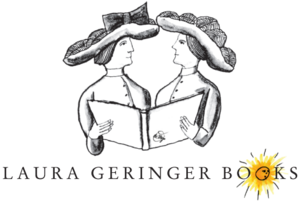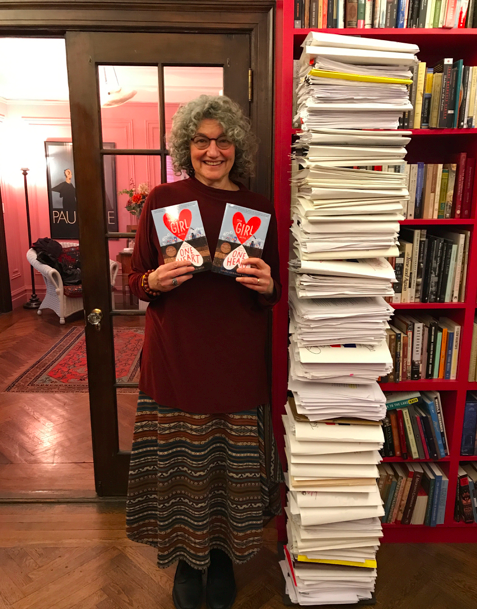Mentors and Mentees in My Life: From Charlotte Zolotow to Girls Write Now
One of the signs noted at the anniversary of the women’s march on January 20 in New York City was “Fight Like a Girl!” I spent the day which fell during National #Thank Your Mentor month with fifty talented young women at GIRLS WRITE NOW talking about fighting -- and writing.
“How do you fight bigotry?” asked one Muslim young woman wearing a hijab. It was a big question I had no easy answer to but a tall high school junior from Haiti stood and answered for me: “By writing about it,” she said.
“How do you deal with your feelings when you write? How do you keep from crying,” asked another.
“I do cry when I write sometimes,” I said.
“How do you keep on writing and writing when it’s so hard?”
“How do you know what you have to say is worth it?”
I’m a mentor at Girls Write Now because mentors have played such an important part in my life. Here I am with Saradine Nazaire, my mentee at Girls Write Now, putting hats and heads together at one of our weekly meetings where we share coffee, pastry and thoughts about writing.
When I was 21 years old, an English major like so many others just out of college with no idea how to earn a living, I landed a job as a book reviewer at School Library Journal. For three years, every published children’s book crossed my desk. I was doing what I loved—reading and writing about books—but I wasn’t yet pursuing my real dream—to write a book of my own.
I had begun to take notes for a middle-grade novel but hadn’t told anyone about it, not even my mother, my very first editor. And that’s where a mentor comes into my story. She was a legend in her own time, the author of over 75 books for young people who was also the publisher at Harper and Row, now HarperCollins. Charlotte Zolotow. As a book reviewer, I had become friendly with the late great Bill Morris, a wickedly funny, erudite man with impeccable taste in literature—a legend himself although I didn’t know it at the time. Bill let it be known that there was an opening for an editor at Harpers. I applied.
Within a few minutes of meeting Charlotte, we were chatting like old friends about books we both loved and favorite authors and then, towards the end of what didn’t feel like a job interview I found myself telling her my secret: I had started work on my own novel. That’s when I got to see her famous smile, the one she reserved for authors. “I hope when you’re ready you’ll show it to me,” she said.
I walked out of Charlotte’s office on air but I was scared to show her my writing, scared it wasn’t good enough, scared I wasn’t good enough. It took me about a year after I went to work at Harpers to gather the courage to show her an early draft of the story that became SILVERPOINT, my first published novel.
So a bit of advice I gave the mentees gathered at GIRLS WRITE NOW that sunny winter’s day of the women’s march was: Be brave. When the opportunity presents itself (and it will) show your work. Let folks read it.
In anticipation of the launch of my new novel for young people, THE GIRL WITH MORE THAN ONE HEART, due out from Abrams this Spring, I want to say thank you to my first writing mentor Charlotte Zolotow who gave me my start and to Bill Morris who introduced us.
A second mentor story:
When I was in college I would habitually buy multiple copies of books I loved so I could give them as gifts to friends. One such book was a beautiful edition of Christian Morgenstern’s GALLOWS SONGS, translated from the German by W.D. Snodgrass and Lore Segal and perfectly matched by a series of profoundly playful drawings by Paul Klee. I treasured the verses and read them over and over, delighted by the “wing-burdened” Korf who binds himself into a book and wanders through the world “with pages fluttering…” having invented a “daynightlamp…which with one flick of the switch turns day, however bright, to blackest night.” That book was a world into which I could escape whenever undergraduate life got me down. The marvelous nonsense that punctuates the poems and comes in delicious “fluttertatas” of sound (spoonaleea, spoonalaya, spoonaleia, loo) made me dance around my room, reciting to mirrors.
I never imagined that years and years later, heavy in spirit after the death of my father and struggling mightily with THE GIRL WITH MORE THAN ONE HEART, I would be lucky enough to meet Lore Segal and join her small living room workshop of writers. By then of course, I was also familiar with Lore’s brilliant translation of THE JUNIPER TREE and OTHER TALES FROM GRIMM illustrated by Maurice Sendak, as well with as her classic picture books, short stories and novels. So let me here thank and celebrate my friend and mentor Lore Segal and that fortunate turn of events that caused our paths to cross. Lullalee, lullalei, lullalaya, loo, I am grateful to the fate that brought us together.
Finally, a third mentor story:
I met Tamar Brazis, the editor of THE GIRL WITH MORE THAN ONE HEART twenty years ago. She was twenty-one years old, just out of school, and she came to my office to apply for her first job in publishing. I became her mentor just as Charlotte had been mine and we worked together for six years before she went on to Abrams to become an editor there. I was so proud of Tamar and thought of her as my daughter in publishing. Years later, I showed her an early draft of what was to become THE GIRL WITH MORE THAN ONE HEART and she became my editor—and so in a sense, my mentor--one of the circles in life that gives me great joy.
Tamar first read my book when it was a memoir and has seen it through many, many, revisions. When it came to this story in which I drew so directly from the lives of members of my own family, there were no shortcuts. I told it in third person, then in first. I aged my heroine, Briana down, then I aged her up. Her Grandpa, a character based on my own father, told many (too many) shaggy dog stories within the framework of the plot, and then finally, he told only one. And so on.
Here’s a photo of me standing in front of my stack of revisions for THE GIRL WITH MORE THAN ONE HEART. It’s taller than I am and I’m six feet tall.
How do you keep writing and writing when it’s so hard ”
“How do you know that what you have to say is worth it?”
In answer to that question, I turn to George Saunders on the subject of revision:
“The writer is like the optometrist, always asking: Is it better like this? Or like this? The interesting thing is that the result of this laborious and obsessive process is a story that is better than I am in “real life”—kinder, wiser and more entertaining. And what a pleasure that is; to be, on the page, less of a dope than usual.”
Thank you to Charlotte and to Lore and to Tamar, who helped me be, on the pages of THE GIRL WITH MORE THAN ONE HEART, less of a dope than usual and who gave me faith that the story I had in my heart through all these years of writing and re-writing, was worth it.






